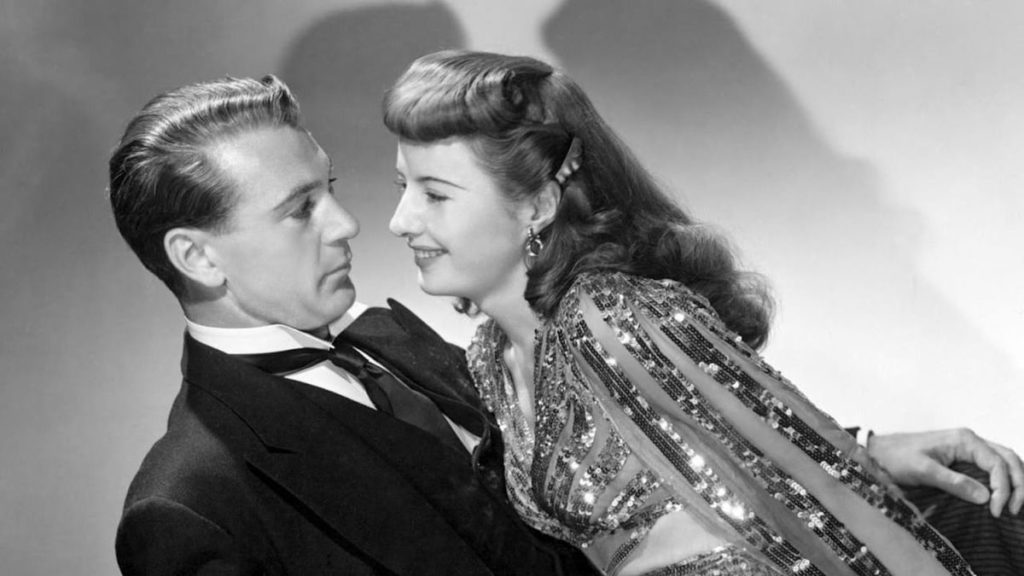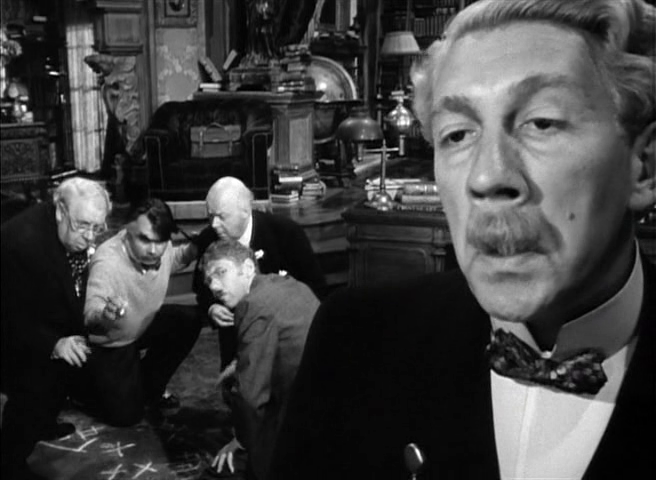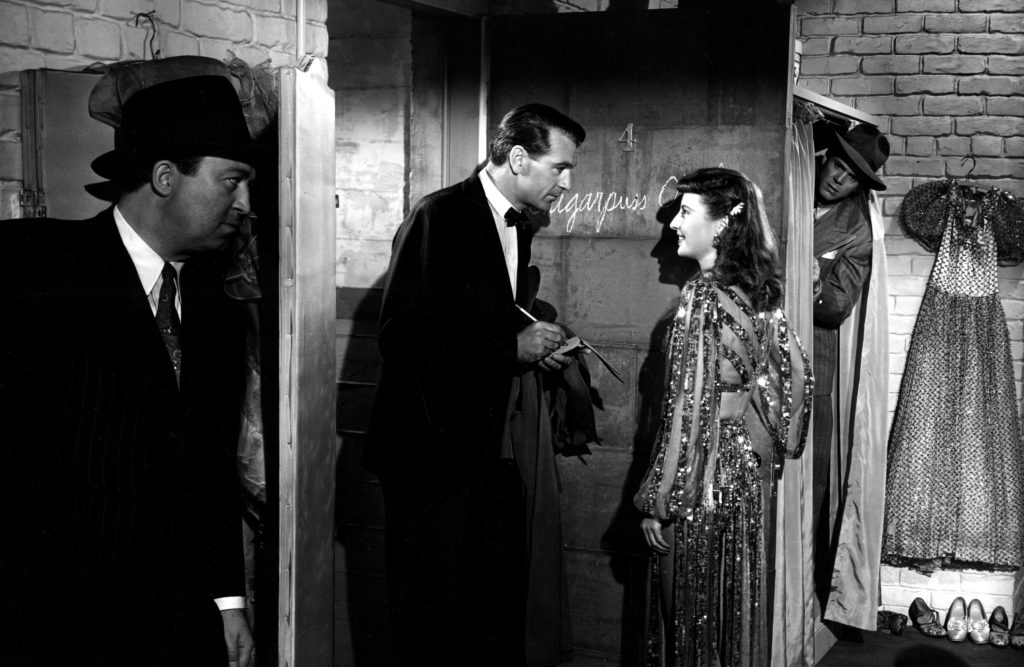| Matt Levine |

Ball of Fire plays at the Trylon Cinema from Friday, December 30 through Sunday, January 1. Visit trylon.org for tickets and more information.
At first glance, Ball of Fire seems like a prototypical screwball comedy. Directed by Howard Hawks, who helmed at least three classics of the subgenre—Twentieth Century (1934), Bringing Up Baby (1938), and His Girl Friday (1940)—Ball of Fire throws two mismatched paramours together and observes their squabbling before love conquers all. Barbara Stanwyck, a name almost as synonymous with screwball as Hawks himself (she starred in The Lady Eve less than a year before Ball of Fire was released), plays Katherine “Sugarpuss” O’Shea, a gangster’s moll on the run from the police, who hides out in a dusty New York manor with eight stodgy professors compiling an encyclopedia. One of them is played by Gary Cooper, who (while generally considered a more dramatic and laconic actor) starred in Ernst Lubitsch’s Design for Living (1933) and Frank Capra’s Mr. Deeds Goes to Town (1936). Inevitably in Ball of Fire, Stanwyck’s world-weary, fast-talking dame melts Cooper’s icy aloofness while he teaches her that there’s more to life than money and self-reliance. In short, from director to cast to storyline, we are firmly in the realm of screwball romance.
But the movie isn’t quite as simple as that, which might be why it’s rarely mentioned among the other screwball classics. For one thing, the question of authorship is complicated by the fact that Hawks can’t be considered the sole auteur. For sure, there are themes and motifs that we may recognize from Hawks’ other films: a focus on male camaraderie; a stellar example of the tough, unflappable “Hawksian woman” (an echo of Rosalind Russell in His Girl Friday); and the primacy of labor, depicting professionals going about their business despite any philosophical qualms they might have. There’s also Hawks’ elegant but unobtrusive visual form, one of the epitomes of Hollywood’s Golden Age, consisting largely of static medium shots or a camera whose movements are dictated by narrative progression.
Nonetheless, the contributions of the cast and crew must be acknowledged as playing a major role in shaping the film. Every Hollywood production is the amalgamation of countless talented artists and technicians—a point which should be self-apparent, although critics have the habit of giving precedence to the director on almost every occasion. At the risk of stating the obvious, Ball of Fire isn’t only Hawks’ film—it’s also Stanwyck’s and Cooper’s and many others’. In addition to the two stars, the supporting cast reads like a who’s who from comedy and gangster pictures in the early 1940s, including Dana Andrews as Stanwyck’s slimy lover, a gangster named Joe Lilac, and Dan Duryea as Andrews’ henchman Pastrami. Meanwhile, the gang of lovably pedantic professors (a loose parody of Snow White and the Seven Dwarfs, which Disney had just released four years prior) includes: Henry Travers, who’s probably best known as Clarence from It’s a Wonderful Life (1946), though he also starred in Mrs. Miniver (1942) and Shadow of a Doubt (1943); the Russian-born Leonid Kinskey, who landed a role in Casablanca (1942) because he was Humphrey Bogart’s drinking buddy; and the Austrian Oskar Homolka and Hungarian S.Z. Sakall, two actors who fled their native lands for Hollywood when the Nazis came to power.
This may sound overly utopian, but such an esteemed international cast suggests Hollywood as a cosmopolitan gathering place for those persecuted before and during World War II. This rosy (and, of course, not entirely accurate) view of the United States is reflected by Ball of Fire’s love of New York City, which an opening title deems “a great, tall forest” in an effort to lend the film a sense of fairy tale whimsy. Most of the classic screwball comedies focus largely on their stars: it’s often Clark Gable and Claudette Colbert, or Cary Grant and Rosalind Russell, or John Barrymore and Carole Lombard who provide their films’ central conflicts. Ball of Fire more diplomatically spreads its attention across a vast and captivating ensemble.

Equally decisive contributions were made by the crew behind the camera. Ball of Fire’s visual style was achieved by Gregg Toland, the cinematographer who pioneered the use of deep focus in Citizen Kane (released the same year). Even if Hawks was known as an “invisible stylist,” Ball of Fire features at least three visually remarkable sequences. In the first, Cooper’s character, Bertram Potts, goes to a nightclub to learn New York street slang when a graceful crane shot swoops all the way from the crowd to the stage where Sugarpuss O’Shea slinks out in a sequined nightgown. In the second, one of the professors (Richard Haydn as the delightful Professor Oddly) attempts to dance the conga in extreme close-up on the right side of the frame while the other professors look on in the background to the left, also sharply in focus (see the image above). In the last instance, Stanwyck’s face is barely visible in a dark room, her bright eyes expressive as she listens to Potts’ declaration of love (the effect was achieved by Toland smearing black greasepaint all over Stanwyck’s face—a presumably unpleasant price to pay for one of the film’s most striking images). It’s fascinating to hypothesize where Hawks’ contributions ended and where Toland’s began in crafting Ball of Fire’s visual style, which is more adventurous than in many other screwball comedies. Given Toland’s innovations in depth of field, lighting, and camera angle (especially low-angle shots), one assumes that he nudged Hawks’ aesthetic in unexpected directions, though the editing is still very Hawksian, cutting infrequently and usually at a pace dictated by the dialogue.
Another significant influence was provided by screenwriter Billy Wilder, who had written a draft of the screenplay titled From A to Z while in Germany. Like his countryman Oskar Homolka (who plays Professor Gurkakoff), Wilder was born in Austria, worked for years in the German film industry, then fled to Hollywood in the ‘30s after Hitler was appointed chancellor. In the US, Wilder quickly rose to prominence as a screenwriter with his working partner Charles Brackett. The duo received acclaim in the late 1930s with such scripts as Bluebeard’s Eighth Wife (1938) and Ninotchka (1939). They collaborated again on Ball of Fire, with Thomas Monroe receiving story credit. On the set, Hawks allowed Wilder to observe his every move, knowing that the screenwriter wanted to move into directing himself. Indeed, Ball of Fire was the last Hollywood movie that Wilder wrote but didn’t direct, as his debut behind the camera, The Major and the Minor, came out the following year (1942).
One of the defining characteristics of Wilder and Brackett’s scripts is the unique blend of eager Americana with cynical social commentary, so memorably evoked in movies like Ninotchka and Sunset Boulevard (1950). (This was arguably even more true of some of the films Wilder wrote without Brackett, like Ace in the Hole [1951] and One Two Three [1961]). In Ball of Fire, there’s a love for distinctly American artifacts like jazz music and the kind of street slang that evolves daily. The first of these is presented through a performance of “Drum Boogie” by Gene Krupa and his orchestra that offers showstopping percussion, fantastic sax and trumpet solos, even an encore rendition that Krupa performs on a table with two matchsticks. This scene also features the Black trumpeter Roy Eldridge at a time when roles for Black artists were rare in movies made for predominantly white audiences.
Ball of Fire’s adoration for American slang is even more pronounced, providing the narrative thrust of the film. Cooper’s character, a linguistics expert, has spent years compiling examples of slang, only to realize in a single conversation with a trash collector that he’s woefully out of touch with the newest vernacular. So he wanders the streets, attends a baseball game, rides the subway, and hires a throng of “common folk” (including Stanwyck’s nightclub singer) to school him in such colloquialisms. He even admiringly quotes Carl Sandburg: “Slang is a language that rolls up its sleeves, spits on its hands, and goes to work.” Throughout the course of the film, we’re treated to amusing argot such as “shove in your clutch,” “patch my pantywaist,” “sucker for succotash,” “crabapple Annie,” and “squirrel fever”—the latter a euphemism for the romantic urge, which could serve as a fitting descriptor for screwball comedies in general.
Legend has it that Wilder and Brackett themselves visited drugstores, burlesque houses, high schools, and racetracks to learn these slang expressions. The result is a movie that’s not only verbally dazzling—as are all of the great screwball comedies—but that revels in the language of the streets, far removed from the polished parlance of, say, Trouble in Paradise (no disrespect to one of Lubitsch’s best films). Therein lies Ball of Fire’s subversive streak: against the titans of knowledge (the academic kind embraced by the encyclopedic professors), money (represented by the gangster, Joe Lilac, who intends to make Sugarpuss O’Shea a kept woman), and justice (symbolized by the police who are hot on Sugarpuss and Lilac’s tails), it is populist culture (and, of course, true love) that win out in the end.

That approach to American class strata is also what makes Ball of Fire somewhat unique among screwball comedies. The subgenre rose to prominence in the 1930s as Americans felt the hardships of the Great Depression. Many could barely scrape together money for food and shelter yet found a way to pay five or ten cents for a movie ticket. (In fact, by 1939, cinema was the eleventh-largest industry in the US.1) During the 1930s, audiences expected some kind of class critique but also craved a level of glamor and escapism from the movies they paid their hard-earned money to watch. Through screwball comedies, viewers could vicariously experience the rich and extravagant lives of movie stars while also noting the economic inequality of America and their own disenfranchisement. This seeming paradox helps to explain the massive success of screwball comedies in the 1930s and beyond.
Ball of Fire, then, is not alone in paying attention to class disparity, but it is one of the relatively few screwball comedies that deemphasize the world of the upper classes. Other examples of the subgenre have various narrative structures as far as class is concerned. Some, like It Happened One Night (1934) and Sullivan’s Travels (1941), feature wealthy, privileged characters who, intentionally or not, “slum it” with the have-nots and see how the other half lives. Then there are those that feature impoverished characters who are suddenly jettisoned into the world of the wealthy elite, like My Man Godfrey (1936), Holiday (1938), and The Palm Beach Story (1942). Still others are almost entirely ensconced in the upper class, though they point out that world’s absurdities in various ways—movies like The Awful Truth (1937) and The Philadelphia Story (1940) come to mind.
Although several screwball comedies are set in the rough-and-tumble world of journalism (like Libeled Lady [1936] and His Girl Friday), Ball of Fire is one of the few that explicitly shows allegiance with the “common folk”—the nightclub singers, trash collectors, and newspaper vendors who turn slang into music, using language in ways that are not sanctioned by the dictionary. Even the eight professors toiling away in their manor are only able to do their work because they’re supported by a prudish heiress, and Joe Lilac’s wealth is revealed to be gained through violence and coercion. Ball of Fire, in other words, equates money with repression and amorality, and the lack of money with freedom and spontaneity.
Maybe that’s why Ball of Fire, which is rarely mentioned in the same breath as revered classics like Bringing Up Baby, still feels so fresh and invigorating: it’s not only about romantic love but also love of life, love of pop culture, love of people who aren’t shackled by structures of knowledge or capitalism. Such a reading might make both Hawks and Wilder cringe; they often mock characters who take politics too seriously, who think in terms of right- or left-wing instead of the average person’s lived reality (as evidenced by Ball of Fire’s brief joke about the Communist newspaper The Daily Worker). Regardless, it’s impossible to ignore the implications of how the film deviates from the screwball comedy template. Doing so, as Ball of Fire’s beloved slang might put it, would make you a real sucker for succotash.
NOTES
1 Cook, David A. “History of Film,” Encyclopedia Britannica, https://www.britannica.com/art/history-of-the-motion-picture/The-Hollywood-studio-system. Accessed December 20, 2022. (Yes, I realize the irony of citing an encyclopedia article in the context of a movie that gently pokes fun at encyclopedic knowledge.)
Edited by Olga Tchepikova-Treon
